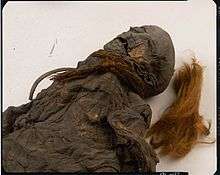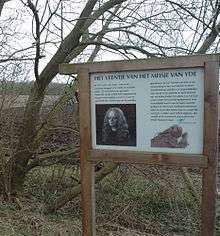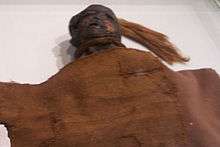Yde Girl
Yde Girl (English: /ˈɪdə/ (![]()


Examination

Carbon-14 tests have indicated that Yde Girl died between 54 BCE and 128 CE at an approximate age of 16 years.[2] She had long reddish blond hair, but one side of her head was initially thought to have been shaved before she died. Recent studies of Windeby I, however, have suggested that the shaved hair phenomenon in some bog bodies may simply attest to one side of the head being exposed to oxygen slightly longer than the other. Scans have shown that she suffered from scoliosis. She stood at 137 centimetres (4 ft 6 in), which is comparatively small for a sixteen-year-old.[2]
The body was found clad in a woolen cape and with a woolen band, made in a braiding technique known as sprang, wrapped around the neck, suggesting she was executed or sacrificed.[4][5] There was also a stab wound in the area of her collarbone, but that was not determined as the cause of death. It is thought that she may have died while unconscious, as defensive wounds were absent on the hand that was recovered from the body, unlike a similar case in Germany, the Kayhausen Boy, who had a cut on his left hand from an apparent defense attempt.[2] As with most bog bodies, the skin and features are still preserved because of the tannic acid in the marsh water. When Yde Girl was excavated, the diggers accidentally caused a wound to the skull. Only the torso of the girl, the head, the right hand and the feet remain intact today. The rest of her body was not preserved or had been damaged by peat cutting tools.
Exhibit

The Yde Girl was put on display and further study was not carried out on the remains until 1992. Richard Neave, of University of Manchester, took a CT scan of the skull of Yde Girl and determined her age, both anatomically and historically.[3][4][6] The Yde Girl became internationally known when Neave made a reconstruction of her head, using techniques from plastic surgery and criminal pathology.[7] Due to the state of the body, the work on the reconstruction included some guesswork, for example, the nose and some other facial features.[2] Yde Girl and her modern reconstruction are displayed at the Drents Museum in Assen.
Yde Girl, along with Roter Franz and the Weerdinge Men, were transported across the world for a museum tour in both the early and mid 2000s.[3][4][5] Due to the intensity of the girl's death, protests in Canada prevented the tour from traveling through several locations in the country.[8]
References
- van der Sanden, Wijnand (1990). Mens en moeras: veenlijken in Nederland van de bronstijd tot en met de Romeinse tijd. Assen: Drents Museum. pp. 61 Fig 12. ISBN 90-70884-31-3.
- Deem, James M. "Drents Museum in Assen, the Netherlands: The Yde Girl". Archived from the original on 17 May 2014. Retrieved 16 May 2014.
- Anderson, Sue Ellen (14 August 2005). "Visit the mummies before they leave for L.A." Sunday Gazette-Mail. Archived from the original on 29 June 2014. Retrieved 16 May 2014.
- "BEST MUSEUM EXHIBIT: THE MYSTERIOUS BOG PEOPLE". Pittsburgh City Paper. 7 December 2005. Archived from the original on 29 June 2014. Retrieved 16 May 2014.(subscription required)
- Nephin, Dan (6 July 2005). "Mummy Exhibit Shows Off Interactive Side". AP Online. Archived from the original on 29 June 2014. Retrieved 16 May 2014.(subscription required)
- Mohd Isa, Marisa (6 January 2006). "Unveiling mummy secrets". News Straits Times. Archived from the original on 29 June 2014. Retrieved 16 May 2014.(subscription required)
- Prag, John; Neave, Richard (1997). Making faces: using forensic and archaeological evidence [Bodies from the Bog]. London: British Museum. pp. 157–171. ISBN 0-7141-1743-9.
- Bourrie, Mark (13 January 2003). "CULTURE-CANADA: 'BOG PEOPLE' MUMMIES PROVOKE PROTESTS". Inter Press Service English News Wire. Retrieved 16 May 2014.
External links
| Wikimedia Commons has media related to Girl of Yde. |
- Yde Girl – as discovered and facial reconstruction at James M. Deem's Mummy Tombs site.
- National Geographic September 2007: "Tales From the Bog"